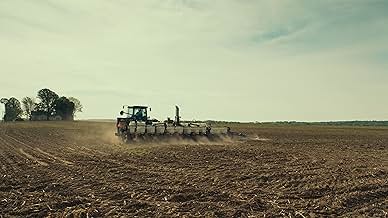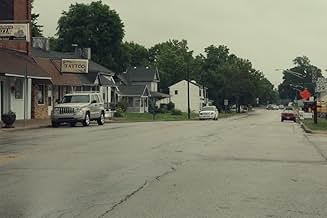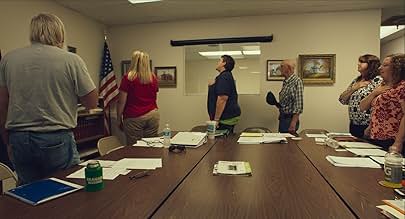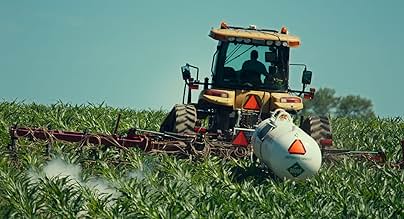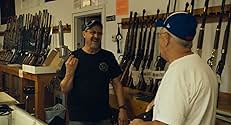Monrovia, Indiana
- 2018
- Tous publics
- 2h 23min
NOTE IMDb
7,0/10
706
MA NOTE
Après l'élection présidentielle de 2016, le documentaire de Frederick Wiseman se penche sur les petites villes américaines pour comprendre en quoi leurs valeurs ont un impact sur la scène po... Tout lireAprès l'élection présidentielle de 2016, le documentaire de Frederick Wiseman se penche sur les petites villes américaines pour comprendre en quoi leurs valeurs ont un impact sur la scène politique du pays.Après l'élection présidentielle de 2016, le documentaire de Frederick Wiseman se penche sur les petites villes américaines pour comprendre en quoi leurs valeurs ont un impact sur la scène politique du pays.
- Réalisation
- Récompenses
- 1 victoire et 4 nominations au total
Avis à la une
The film Monrovia Indiana is a truly remarkable achievement in that just when you think it cannot possible go on any longer, it just keeps going, much like the Great Crossroads itself. This is a shame.
Contrast with Hale County. That film too turned the camera on an overlooked slice of America, and yet it transcended the typical narrative to reveal something more, something unexpected. A conversation with a man burning leaves turned into the sublime. It provided space for you to think and reflect. Mr. Weisman on the other hand seems to believe that shots of coke in the supermarket are quite subversive, and that it is dreadfully important that viewers experience a full length Masonic ceremony, stumbling and stammering and all. Even Gopher Prairie is a more flattering portrait of small town America than this.
Oh and here's a shot of a field. Wow that sure is a field! And oh here's a shot of a building. That's sure some building there! It all literally looks like google street view.
And oh and now they've been talking about a bench for five minutes. And now a dog is getting its tail amputated for who knows why. And now we are at the mattress store. And now we're in church. Just kill me now.
I refuse to believe that America can possibly be as dull, as small, and as ugly as it is presented as here. There is no profound insight in debating a bench! There is nothing to reveal in a mattress warranty! This is not art but a caricature that has the gall to try passing itself off as an auteur's quietly documentary of real America.
In short: this is a film we've all seen before and do not ever need to see again. It's amazingly boring both visually and narratively, and conceptually bankrupt. The best that can be said of this self indulgent mess is that it quickly and unknowingly descends into self parody.
Contrast with Hale County. That film too turned the camera on an overlooked slice of America, and yet it transcended the typical narrative to reveal something more, something unexpected. A conversation with a man burning leaves turned into the sublime. It provided space for you to think and reflect. Mr. Weisman on the other hand seems to believe that shots of coke in the supermarket are quite subversive, and that it is dreadfully important that viewers experience a full length Masonic ceremony, stumbling and stammering and all. Even Gopher Prairie is a more flattering portrait of small town America than this.
Oh and here's a shot of a field. Wow that sure is a field! And oh here's a shot of a building. That's sure some building there! It all literally looks like google street view.
And oh and now they've been talking about a bench for five minutes. And now a dog is getting its tail amputated for who knows why. And now we are at the mattress store. And now we're in church. Just kill me now.
I refuse to believe that America can possibly be as dull, as small, and as ugly as it is presented as here. There is no profound insight in debating a bench! There is nothing to reveal in a mattress warranty! This is not art but a caricature that has the gall to try passing itself off as an auteur's quietly documentary of real America.
In short: this is a film we've all seen before and do not ever need to see again. It's amazingly boring both visually and narratively, and conceptually bankrupt. The best that can be said of this self indulgent mess is that it quickly and unknowingly descends into self parody.
The documentary was cute and artsy but continues on for so long without much direction. Were it to delve more into some specifics of personal life in much less time, it may be more interesting, but the amount of time where absolutely nothing consequential is going on in the movie is mind numbing.
Very weird seeing a documentary about a small town 15 minutes from where I live, and that I've spent a decent chunk of time in. Seeing it from an outsider's perspective was different, and seeing all of these roads I've driven on through a camera lens was an odd experience. Honestly surprised the director found enough content in Monrovia to make an almost two and a half hour movie out of, considering I can drive across town in twenty seconds. Still cool, though, never knew this documentary existed. I always like documentaries that show an unfiltered glimpse into the life of others, and this was no different, even though the life it showed was basically the same as the one I live.
The director captured the essence of Indiana small-town life perfectly in this PBS documentary. The citizens of Monrovia are exactly the same personality types that I met during my time in rural Indiana about 40 years ago. It appears that nothing has changed.
I lived in Clayton, Indiana for about 4 years. Clayton is very close to Monrovia, which had the only bank in the area. I came from the Seattle, WA area, so the whole culture and landscape of Clayton and Monrovia were foreign to me - the flat fields as far as the eye could see and beyond. The social life of people in these farm areas is very structured and life experiences are limited by the narrow perspective of a strictly proscribed culture. I ended up in Indiana because my husband and I wanted to established a thoroughbred stud farm and his parents had a large parcel of land. When we got there and realized what a different landscape and social structure we found ourselves, I regretted moving there almost immediately. I was in a strange place and I had a lot to learn about middle America culture. People knew that I was not local. Not just from my (non-Southern) accent, but from my questions about (1) the religious emphasis in daily life, l(2) seeming lack of interest in local or national government, and (3) attitudes about women and their "place" in society.
After returning to the Pacific Northwest after 4 years and Iooking back on my experiences in Clayton and Monrovia, I had a better idea about how people in different parts of America think about life and society in general. Where we live molds our perspective through exposure to different people and different landscapes.
I lived in Clayton, Indiana for about 4 years. Clayton is very close to Monrovia, which had the only bank in the area. I came from the Seattle, WA area, so the whole culture and landscape of Clayton and Monrovia were foreign to me - the flat fields as far as the eye could see and beyond. The social life of people in these farm areas is very structured and life experiences are limited by the narrow perspective of a strictly proscribed culture. I ended up in Indiana because my husband and I wanted to established a thoroughbred stud farm and his parents had a large parcel of land. When we got there and realized what a different landscape and social structure we found ourselves, I regretted moving there almost immediately. I was in a strange place and I had a lot to learn about middle America culture. People knew that I was not local. Not just from my (non-Southern) accent, but from my questions about (1) the religious emphasis in daily life, l(2) seeming lack of interest in local or national government, and (3) attitudes about women and their "place" in society.
After returning to the Pacific Northwest after 4 years and Iooking back on my experiences in Clayton and Monrovia, I had a better idea about how people in different parts of America think about life and society in general. Where we live molds our perspective through exposure to different people and different landscapes.
For the record, I arrived 5-10 minutes late.
This documentary provides a well seamed collection of examples of everyday life in a place I've never heard about. History of their sports teams, debates over investing in new residential housing vs new businesses (the newest neighborhood is where the majority of their volunteer firefighters and people who returned to Monrovia reside), freemasons ceremony, WTH is up with the newest neighborhood's fire hydrants, barbershop, hair salon, fitness class, a funeral, etc. Monrovia, Indiana does well at what it intends. This would be an interesting documentary to discuss academically.
Side Note: I did lose my interest at times, but that's a matter of personal taste. Some topics just didn't interest me. The director did a pretty decent job with editing. I give that a B.
This documentary provides a well seamed collection of examples of everyday life in a place I've never heard about. History of their sports teams, debates over investing in new residential housing vs new businesses (the newest neighborhood is where the majority of their volunteer firefighters and people who returned to Monrovia reside), freemasons ceremony, WTH is up with the newest neighborhood's fire hydrants, barbershop, hair salon, fitness class, a funeral, etc. Monrovia, Indiana does well at what it intends. This would be an interesting documentary to discuss academically.
Side Note: I did lose my interest at times, but that's a matter of personal taste. Some topics just didn't interest me. The director did a pretty decent job with editing. I give that a B.
Le saviez-vous
- AnecdotesShot in ten weeks.
Meilleurs choix
Connectez-vous pour évaluer et suivre la liste de favoris afin de recevoir des recommandations personnalisées
Détails
Box-office
- Montant brut aux États-Unis et au Canada
- 63 944 $US
- Week-end de sortie aux États-Unis et au Canada
- 5 172 $US
- 28 oct. 2018
- Montant brut mondial
- 64 596 $US
- Durée
- 2h 23min(143 min)
- Couleur
- Rapport de forme
- 1.85 : 1
Contribuer à cette page
Suggérer une modification ou ajouter du contenu manquant



